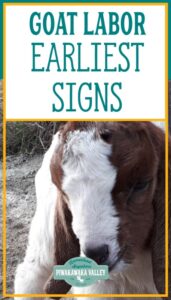If you keep goats on your homestead, you will probably want them to have babies as some stage! Goats due dates can be hard to guess, so how do you know when a goat is ready to give birth? There are some common pregnant goat labor signs that you can keep an eye out for.
Goat Pregnancy Due Dates
Guessing your goats’ due dates can be difficult. Estrus, or heat, is the period in which the doe will stand and allow the buck to breed her.
Please read: This information is provided for educational purposes only and is not intended to treat, diagnose or prevent any disease. We encourage you to make your own health care decisions in partnership with a qualified health care professional.
This post contains affiliate links, this means at no extra cost to you, we make a commission from sales. Please read our Disclosure Statement
This phase of the reproductive cycle may last between 12 to 36 hours. The period from one heat cycle to the next is referred to as the estrous cycle. In goats, the estrous cycle occurs every 18 to 24 days, or 21 days on average. So if you put a buck in with your does, you will need to leave him there for at least a month to catch all their heat cycles.
This will give you an approximate time that they could have gotten pregnant. Of course if the pregnancy doesn’t take in the first cycle, it might happen the next month and this will spread out your birthing dates even further.
How long is a goat pregnancy?
Like human births, a goat pregnancy can vary in length. Generally the gestation period, or length of pregnancy, of the doe ranges between 145 to 152 days, or 150 days (5 months) on average.
So when you add these two numbers together you can get your due date range for your goats. If your doe was on heat the day you introduced the buck and she has a shorter pregnancy, the earliest that she can be due is 145 days from the day you put in the buck.
If she takes the full 24 days to come back in to heat, and has a 152 day pregnancy, then your last day that she should be due is 176 days after you put in the buck.
Because of the 3-4 week variation in due dates within your herd, it is really helpful to know how to pick when your doe is likely to actually birth so that you can keep her somewhere safe, warm and easy to access incase you need to help her.
Detecting pregnancy in a goat without a scan
If you want to know if your goat is in fact pregnant early on, you can ask your vet for a blood test or an ultrasound scan, but most farmers just wait to see external signs of pregnancy in their goats.
Growing belly
Because we see our goats everyday, the subtle changes in her growing body can be hard to keep track of.
It is a good idea to take a few photos of your doe when she isn’t pregnant. You can compare these images to view how your goat is now, sometimes the changes are quite noticeable as her belly grows, especially if she is having more than one baby.
Bagging up
One of the first signs is “bagging udders”. This is the enlargement of the udder. If you have a seasoned doe, she will sometimes “bag up” within a month of giving birth.
First time does tend to bag up later, sometimes only a week to a few days before giving birth.
Movement
Another external sign of pregnancy in your doe is movement. As the babies grow inside her, you will be able to feel kicking. Place a flat hand on her lower right side, in front of her udders, on the inside of her leg. You will often feel the bump of a nose, or the point of a soft hoof.
Pregnant goat labor signs
When your due dates are getting closer, move your goats to an area closer to your house where you can check in on them several times a day.
Feeding them a little grain or sheep nuts in the morning and night can be a way to encourage them to be handled and observed more closely, and gives them the extra nutrition for the end of their pregnancy.
Pre-Labor/Late Pregnancy signs and symptoms
Each goat is different. Your doe may exhibit different signs that she is going into labor and in a different order to the next goat. Some goats are very subtle, others more obvious.
Here are some common pre-labor behaviors, these are the common signs that labour is about to start within the next 24-48 hours:
- Arching and stretching of the back
- Lengthened or awkward tail position
- Pawing at the ground
- Gathering bedding, moving things around with her nose or “nesting”
- Waddling when she walks, a spread to the hind legs
- Difficulty getting comfortable while lying down
- Udder formation
- Teat lengthening and growing in circumference
You might also notice a change in their personality – Our goats greet us by jumping up on their fences/gates/paddocks. I notice our really pregnant girls are reluctant to get up on things and some does that are friendly won’t want to be touched, others might want extra affection.
Early labour signs in goats
Once your doe starts these things, you can expect a baby within the next 12-24 hours. Bring her in close if she isn’t already and check in on her every few hours if you can.
- Pin bone softening
- Leaking from the vulva, or loosing the plug. The discharge often starts clear, then becomes more opaque and thickened as labor progresses.
- Vulva swelling
- Sunken in sides near the hips – the babies have “dropped” or engaged ready to be born
How to check for ligament softening in pregnant goats
The pin bones also known as the ligaments, soften and seem to melt away just before labour. These are super easy to check, and it is best to check them morning and night to gage how close to labour your doe is.
Goats have two cord-like ligaments that run along either side of the very rear portion of their spine towards their tail. They are about the thickness of a pencil and easy to feel in a non pregnant goat and it is good to know what they normally feel like so you can tell when they start to change.
As kidding time gets closer, these ligaments start to become soft, and in the 12 or so hours before birth, they will disappear altogether.
You can check the ligaments by slowly running your thumb and forefinger along either side of the goat’s spine towards the tail as you can see in the video on this page.
When you can pinch your fingers together and almost reach completely around the goat’s tail you know that labor is very near.
“Bagging up” or a tight shiny udder in a pregnant goat
I have heard that a tight and shiny udder is a sign of impending labour, but my goats usually get to this stage AFTER they have had their babies.
So while a tight and shiney udder is a sign that your goat will go into labor soon, don’t expect to see this in every doe. If you see this in your doe, it is worth checking to make sure she didn’t sneak off and give birth without you noticing.
Goats, like deer, will leave their babies somewhere safe to rest while they go off and eat, you don’t want to pen up a doe expecting her to give birth if in fact she already has and the baby is now left out hidden somewhere without her coming back to it!
Later signs of active labour in your goat
Once your goat is in active labour you might find her doing some of the following things:
- Vulva opening lengthening
- Bleating, moaning, grunting heavy panting
- Pawing the ground
- Pushing her head against a wall or fence post
- Waters breaking
Birthing baby kids – delivery time!
When birth starts, the goat might rock a bit and push. She might alternate between standing or lying down.
A bubble filled with liquid will appear from her vulva. This is the amniotic membrane or the water sack. The bubble will come out a little at a time. It might contract slightly after the push is over but it should make progress with each contraction.
You should see two little hooves inside the bubble, then a nose. Sometimes babies are born breech – back feet first.
Clear the nasal passages of the kid as soon as the water sack breaks.
The doe should continue to push and deliver the kid rather quickly. The last of the kid will be delivered swiftly and slides out in one swooshing motion.
For more on goat labour and assisting a labouring doe, read here.
Setting up a birthing suit for a goat
If you can, put your mama goat that is ready to birth in to a warm stall with plenty of clean bedding as soon as you get an inkling that she might be about to give birth.
Goats will naturally go off and hide to have their babies, this can be a concern if you need to help with the delivery, and we have learned first hand the sadness of not knowing when or where the mama is having her baby.
If it is particularly cold at night, a heat lamp can be helpful.
Be sure to have a stash of old towels and some lubricant available in case you need to help dry the babies or reposition them in labour.


